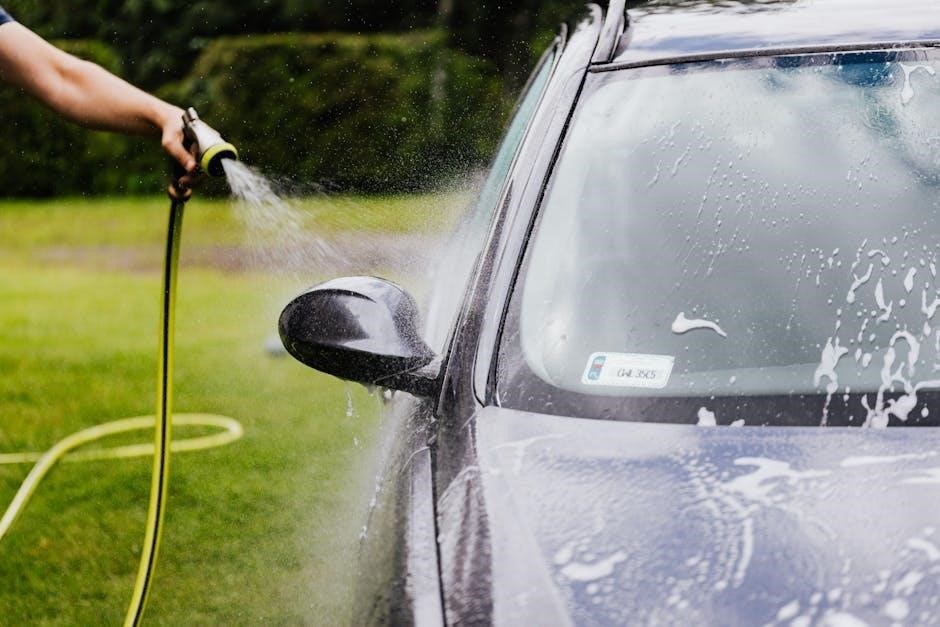A comprehensive guide to garbage compactors is essential for optimal performance and longevity. These manuals offer valuable insights into operation, maintenance, and troubleshooting, empowering users to maintain their appliance effectively. These resources can save time and money.
Importance of Manuals for Optimal Operation
Garbage compactor manuals are vital resources for ensuring the efficient and safe use of these appliances. These manuals provide detailed instructions on proper operation, preventing misuse that could lead to damage or injury. Understanding the compactor’s features and settings, as explained in the manual, allows users to optimize its performance and extend its lifespan. Regular maintenance, as outlined in the manual, is crucial for preventing breakdowns and costly repairs.
Furthermore, manuals often include troubleshooting guides that help users identify and resolve common issues, saving time and money on professional repairs. By following the manufacturer’s recommendations, users can ensure their garbage compactor operates at peak efficiency, reducing waste volume and minimizing environmental impact. Manuals emphasize safety precautions, protecting users from potential hazards associated with the appliance. Ultimately, consulting the garbage compactor manual is essential for maximizing the benefits of this appliance while ensuring safe and reliable operation.
Understanding Your Garbage Compactor
Knowing your garbage compactor is key to efficient waste management. Each model has unique features. Comprehending these specifics ensures you use it correctly. Consult your manual for detailed information. This will prolong the life of your compactor.
Identifying the Model Number
Locating the model number on your garbage compactor is the first step towards accessing the correct information for maintenance and repair. The model number is a unique identifier that helps in finding the appropriate manual, replacement parts, and troubleshooting guides specific to your appliance.
Typically, the model number is printed on a sticker or plate affixed to the compactor. Common locations include:
- Inside the compactor door frame
- On the back panel of the compactor
- Underneath the unit near the base
Once you have located the sticker, carefully note the entire model number. It may include letters, numbers, and dashes. This information is crucial when searching for manuals or parts online.
With the correct model number, you can easily access the manufacturer’s website or online parts retailers to find the right resources for your specific garbage compactor.

Safety Precautions
Prioritize safety when operating or maintaining your garbage compactor. Following safety precautions is paramount to prevent injuries and ensure the appliance functions correctly. Always consult the manual for specific safety guidelines relevant to your compactor model.
Electrical Safety
Garbage compactors, like many appliances, require careful attention to electrical safety. Before performing any maintenance or repairs, always disconnect the compactor from its power source to prevent electrical shock. Never operate a compactor with a damaged power cord; replace it immediately with a manufacturer-approved replacement. Ensure the outlet used is properly grounded and meets the compactor’s voltage requirements.
Avoid using extension cords whenever possible; if necessary, use a heavy-duty extension cord rated for the appliance’s power consumption. Keep the area around the compactor dry to prevent electrical hazards. Do not attempt to disassemble or repair internal electrical components unless you are a qualified technician.
Regularly inspect the power cord for signs of wear or damage. Be aware of any unusual electrical smells or sounds emanating from the compactor, and immediately disconnect it if you suspect a problem. Always consult the manual for specific electrical safety guidelines.
Safe Waste Disposal Practices
Operating a garbage compactor safely involves more than just electrical precautions; it also includes responsible waste disposal practices. Avoid compacting hazardous materials such as flammable liquids, aerosols, or corrosive chemicals, as these can create dangerous situations. Never compact items that could shatter or explode under pressure, like glass containers or pressurized canisters.
Always use the appropriate compactor bags designed for your model to prevent leaks and ensure proper compression. Do not overfill the compactor, as this can strain the motor and lead to malfunctions. Keep children and pets away from the compactor during operation to prevent accidents. Be mindful of sharp objects when loading waste, and consider wrapping them securely to avoid injuries.
Regularly clean the compactor to prevent the buildup of odors and bacteria. Properly dispose of compacted waste in accordance with local regulations. By adhering to these safe waste disposal practices, you can ensure the safe and efficient operation of your garbage compactor.

Troubleshooting Common Problems
Garbage compactors, while reliable, can encounter issues. Understanding common problems enables quick identification and resolution. This section provides guidance on troubleshooting frequent issues, helping you restore your compactor’s functionality and avoid unnecessary service calls. It can save time and effort.
Compactor Not Starting
If your garbage compactor refuses to start, several factors could be responsible. First, confirm the compactor is properly plugged into a functioning power outlet. Check the circuit breaker or fuse box to ensure the circuit hasn’t tripped or the fuse hasn’t blown. A faulty power cord can also prevent the unit from receiving electricity. Inspect the cord for damage and replace if needed.
Next, examine the start switch and directional switch. A malfunctioning start switch won’t initiate the compacting cycle. Similarly, a faulty directional switch may prevent the compactor from recognizing the drawer’s position. The foot pedal, if equipped, could also be the culprit; Make sure it is engaging correctly.
If these checks fail, the drive motor might be defective. A damaged or worn-out motor won’t provide the necessary power to start the compacting process. Consulting the troubleshooting section of your manual or seeking professional repair services is advisable for motor-related issues.
Unusual Noises During Operation
Unusual noises emanating from your garbage compactor during operation often indicate underlying issues. Banging, thumping, squealing, or whining sounds could point to a problem with the drive gear. Turn off power to the unit before removing the bottom cover to inspect the drive gear for wear or damage. Lubricate or replace the gear as needed.
Loud noises might also stem from issues within the motor. A failing motor can produce grinding or screeching sounds. Check for obstructions or debris that may be interfering with the motor’s operation. Additionally, inspect the hydraulic ram for proper lubrication.
Sometimes, unusual noises are caused by the type of waste being compacted. Hard or bulky items can create loud sounds as they are crushed. Consider adjusting your waste disposal practices to mitigate this issue. If the noises persist after addressing these potential causes, consult the manual’s troubleshooting section or seek assistance from a qualified technician.
Ram Stuck or Jammed
A stuck or jammed ram is a common problem encountered with garbage compactors, hindering its ability to compress trash efficiently. If the ram is immobile, begin by disconnecting the power supply to ensure safety during inspection. Examine the compactor for any visible obstructions that may be preventing the ram from moving freely.
Check the directional switch, drive gear, and power nut for any signs of damage or malfunction. The directional switch controls the movement of the ram, and a faulty switch can prevent it from operating correctly. Inspect the drive gear for worn or broken teeth, as this can also impede the ram’s movement.
The power nut, responsible for transferring power to the ram, should also be examined for any cracks or wear. Lubricating the moving parts of the ram can sometimes resolve minor jamming issues. If these steps do not solve the problem, it may be necessary to consult a qualified technician.
Compactor Not Completing Cycle
If your garbage compactor fails to complete its compression cycle, several factors could be at play. Begin by ensuring the compactor is receiving adequate power; a faulty outlet or tripped circuit breaker can interrupt operation. Next, verify that the drawer is fully closed and properly aligned, as some models have safety mechanisms preventing operation if the drawer is ajar.
Inspect the top limit/directional switch; a malfunctioning switch might signal the cycle’s premature end. Examine the drive motor for signs of wear or damage; a failing motor may lack the power to finish the compression. Check the foot pedal, if applicable, ensuring it engages correctly.
Obstructions within the compacting chamber can also impede the cycle; clear any debris hindering the ram’s movement. If these troubleshooting steps prove ineffective, consulting the manufacturer’s manual or seeking professional assistance is advisable to diagnose and resolve more complex issues.

Maintenance and Care
Regular maintenance is key to extending the life of your trash compactor. Proper cleaning and lubrication will prevent problems. Following the recommended maintenance in the manual keeps your appliance running smoothly and efficiently for years.
Cleaning the Compactor
Maintaining a clean garbage compactor is crucial for hygiene and optimal performance. Before cleaning, always disconnect the power supply to ensure safety. Begin by removing any visible debris or garbage from the compactor’s interior. Use a damp cloth or sponge with mild detergent to wipe down the inside walls, the ram, and the drawer. Avoid using abrasive cleaners, as they can damage the surfaces.
Pay close attention to areas where food particles or liquids may have accumulated. For stubborn stains or odors, consider using a solution of baking soda and water. Rinse thoroughly with clean water and dry with a soft cloth. Regularly clean the exterior of the compactor with a damp cloth to remove dust and grime.
Ensure the trash bag attachment points are clean and free from debris to prevent bag tears. By following these simple cleaning steps, you can keep your garbage compactor in excellent condition.
Lubrication of Moving Parts
Proper lubrication of moving parts is essential for the smooth operation and longevity of your garbage compactor. Regular lubrication reduces friction, prevents wear and tear, and minimizes noise during operation. Before lubricating any parts, consult your compactor’s manual for specific recommendations on the type of lubricant to use and the lubrication points.
Typically, you’ll need to lubricate the ram guides, drive gears, and any other moving components. Apply a small amount of lubricant to each point, ensuring it is evenly distributed. Avoid over-lubricating, as excess lubricant can attract dirt and debris. Use a clean cloth to wipe away any excess lubricant.
It is also important to make sure that power screws are lubricated with penetrating oil. Inspect the moving parts regularly for signs of wear or corrosion and re-lubricate as needed. By following a regular lubrication schedule, you can ensure that your garbage compactor operates efficiently and reliably for years to come.

Finding Replacement Parts
When a component fails, locating the correct replacement parts is crucial for a successful repair. Manuals provide valuable information to locate parts and ensure compatibility. Use your model number to find compatible parts for your machine quickly and easily.
Using the Model Number for Parts Identification
The model number is your key to finding the correct replacement parts for your garbage compactor. This unique identifier, typically found on a sticker inside the compactor or on the exterior, unlocks a wealth of information about your specific unit. Always find and record your model number.
When searching for replacement parts, always start with the model number. Entering it into online parts retailers or manufacturer websites will filter the results to show only components compatible with your compactor. This reduces the risk of purchasing the wrong part.
The model number can reveal the exact specifications of your compactor, including the motor type, ram assembly, and control panel. With this information, you can confidently order the precise parts needed to restore your appliance to optimal working condition.
Consult your compactor’s manual to identify the location of the model number. It is usually inside the drawer or on the back panel. Having this number handy simplifies the parts replacement process.



